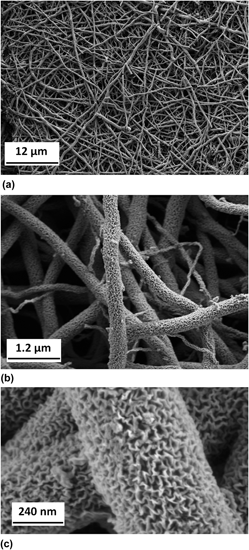Article contents
Mesoporous K/Fe–Al–O nanofibers by electrospinning of solution precursors
Published online by Cambridge University Press: 23 October 2015
Abstract

Nanometer-sized fibers are recently getting increased attention in heterogeneous catalysis due to the superior transport properties and effective dispersion they offer. A key challenge in this application is creation of nanofibers with internal open porosity that can provide larger accessible catalytic surface and easier mass transport into the fibers. The synthesis of potassium doped iron/aluminum oxides ceramic nanofibers with mesoporous structure is presented herein. Uniform fiber mats were prepared by electrospinning (ES) using two different precursors: an aqueous solution of metal nitrates and an organic solution of metal acetylacetonates. The organic precursors gave rise to a promising mesoporous structure with fibers diameter mainly in the 300–400 nm range. Precursor viscosity was used as a stability indicator and its influence on the ES process was studied. Collection efficiency of as high as 90% was achieved. The increased understanding in fiber morphological evolution can open new possibilities in heterogeneous catalysis.
- Type
- Articles
- Information
- Copyright
- Copyright © Materials Research Society 2015
References
REFERENCES
- 4
- Cited by




